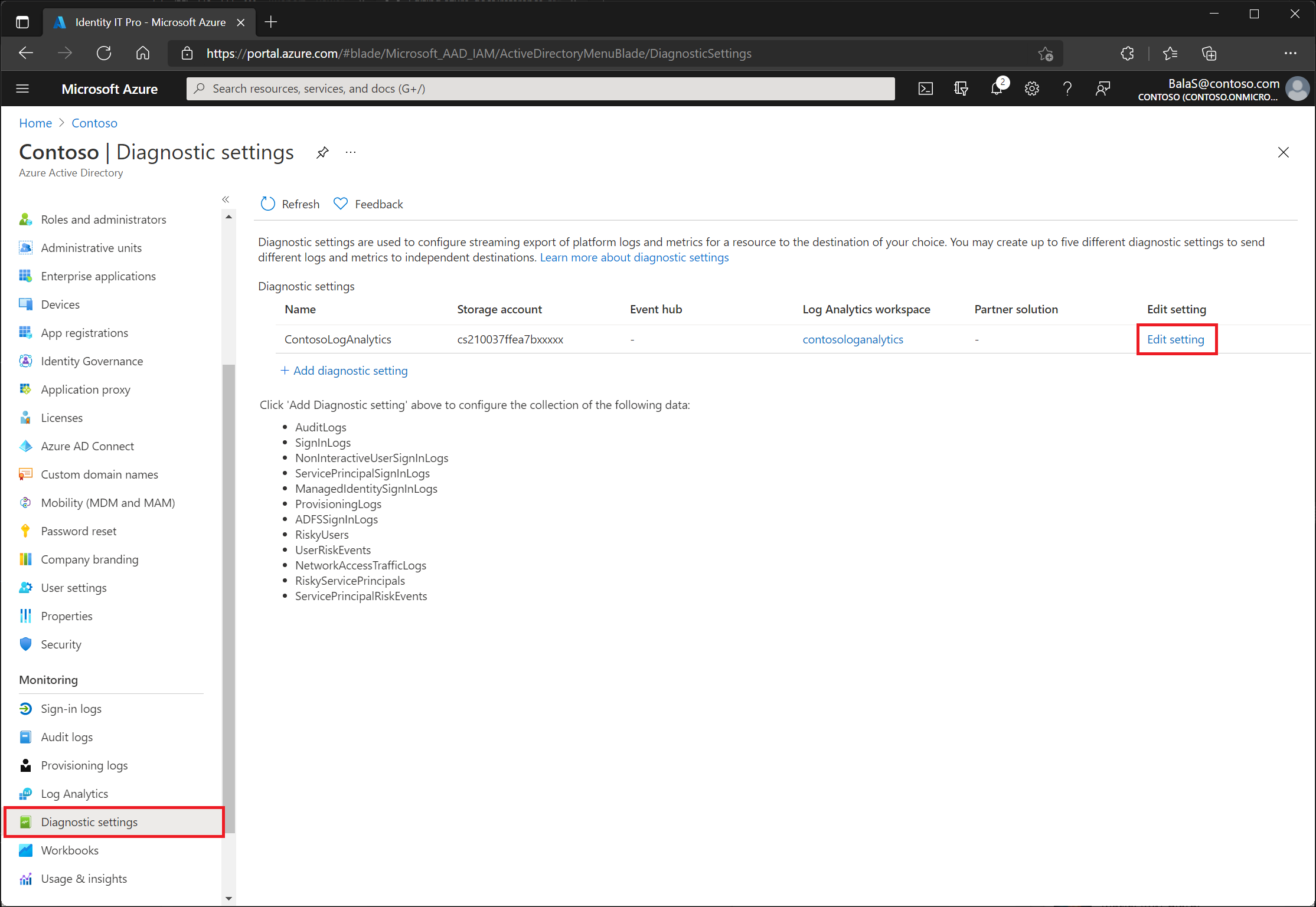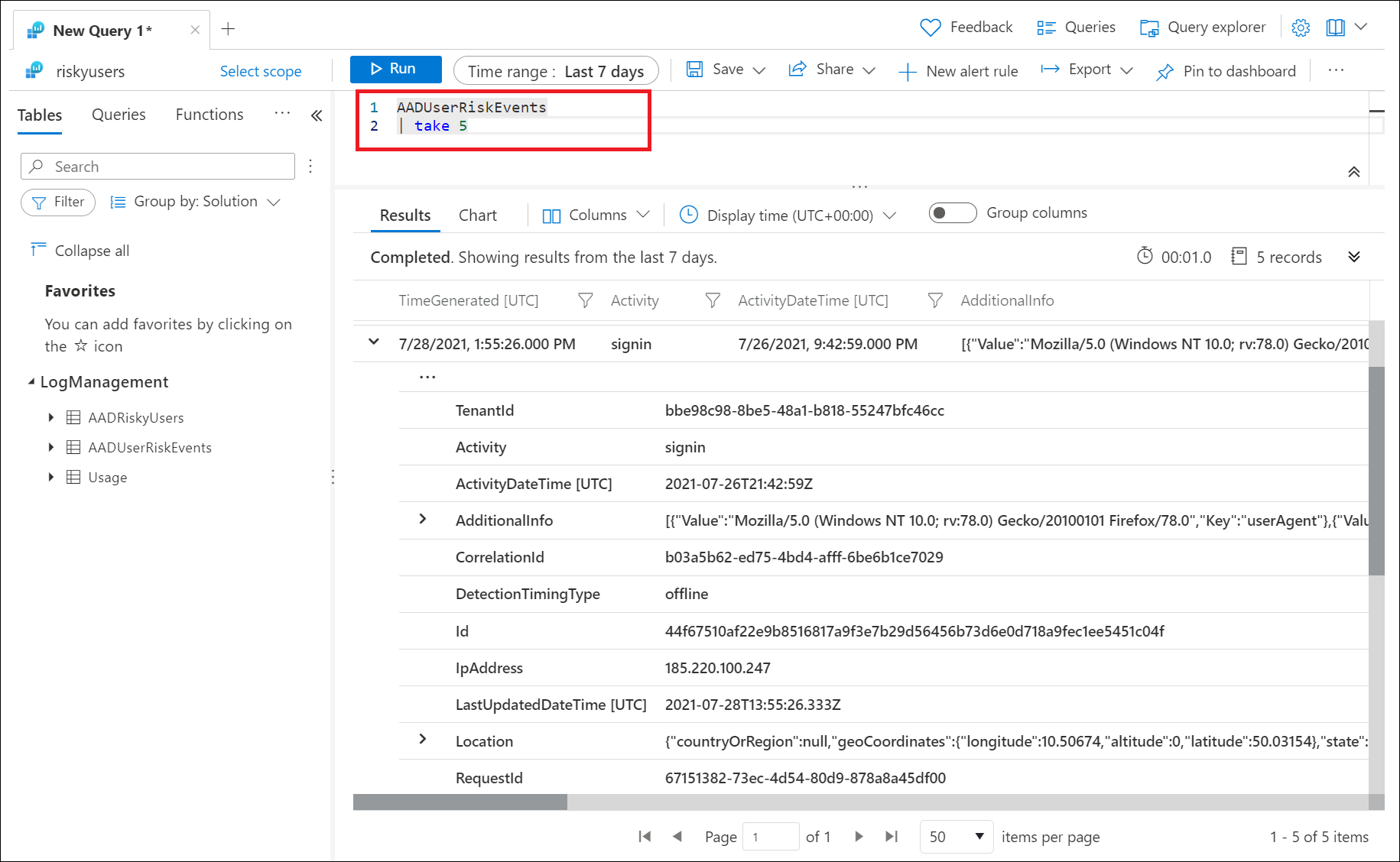How To: Export risk data
Microsoft Entra ID stores reports and security signals for a defined period of time. When it comes to risk information that period might not be long enough.
| Report / Signal | Microsoft Entra ID Free | Microsoft Entra ID P1 | Microsoft Entra ID P2 |
|---|---|---|---|
| Audit logs | 7 days | 30 days | 30 days |
| Sign-ins | 7 days | 30 days | 30 days |
| Microsoft Entra multifactor authentication usage | 30 days | 30 days | 30 days |
| Risky sign-ins | 7 days | 30 days | 30 days |
Organizations can choose to store data for longer periods by changing diagnostic settings in Microsoft Entra ID to send RiskyUsers, UserRiskEvents, RiskyServicePrincipals, and ServicePrincipalRiskEvents data to a Log Analytics workspace, archive data to a storage account, stream data to an event hub, or send data to a partner solution. Find these options in the Microsoft Entra admin center > Identity > Monitoring & health > Diagnostic settings > Edit setting. If you don't have a diagnostic setting, follow the instructions in the article Create diagnostic settings to send platform logs and metrics to different destinations to create one.
Log Analytics
Log Analytics allows organizations to query data using built in queries or custom created Kusto queries, for more information, see Get started with log queries in Azure Monitor.
Once enabled you find access to Log Analytics in the Microsoft Entra admin center > Identity > Monitoring & health > Log Analytics. The following tables are of most interest to Microsoft Entra ID Protection administrators:
- AADRiskyUsers - Provides data like the Risky users report.
- AADUserRiskEvents - Provides data like the Risk detections report.
- RiskyServicePrincipals - Provides data like the Risky workload identities report.
- ServicePrincipalRiskEvents - Provides data like the Workload identity detections report.
Note
Log Analytics only has visibility into data as it is streamed. Events prior to enabling the sending of events from Microsoft Entra ID do not appear.
Sample queries
In the previous image, the following query was run to show the most recent five risk detections triggered.
AADUserRiskEvents
| take 5
Another option is to query the AADRiskyUsers table to see all risky users.
AADRiskyUsers
View the count of high risk users by day:
AADUserRiskEvents
| where TimeGenerated > ago(30d)
| where RiskLevel has "high"
| summarize count() by bin (TimeGenerated, 1d)
View helpful investigation details, such as user agent string, for detections that are high risk and aren't remediated or dismissed:
AADUserRiskEvents
| where RiskLevel has "high"
| where RiskState has "atRisk"
| mv-expand ParsedFields = parse_json(AdditionalInfo)
| where ParsedFields has "userAgent"
| extend UserAgent = ParsedFields.Value
| project TimeGenerated, UserDisplayName, Activity, RiskLevel, RiskState, RiskEventType, UserAgent,RequestId
Access more queries and visual insights based on AADUserRiskEvents and AADRisky Users logs in the Impact analysis of risk-based access policies workbook.
Storage account
By routing logs to an Azure storage account, you can keep it for longer than the default retention period. For more information, see the article Tutorial: Archive Microsoft Entra logs to an Azure storage account.
Azure Event Hubs
Azure Event Hubs can look at incoming data from sources like Microsoft Entra ID Protection and provide real-time analysis and correlation. For more information, see the article Tutorial: Stream Microsoft Entra logs to an Azure event hub.
Other options
Organizations can choose to connect Microsoft Entra data to Microsoft Sentinel as well for further processing.
Organizations can use the Microsoft Graph API to programmatically interact with risk events.

